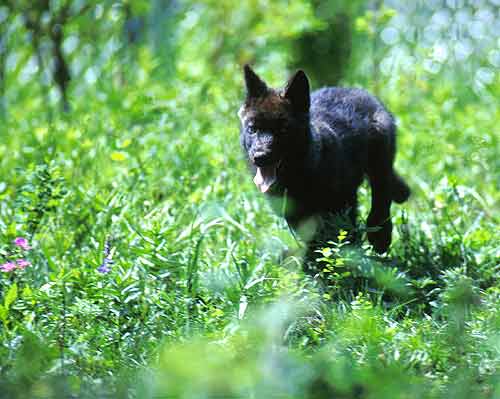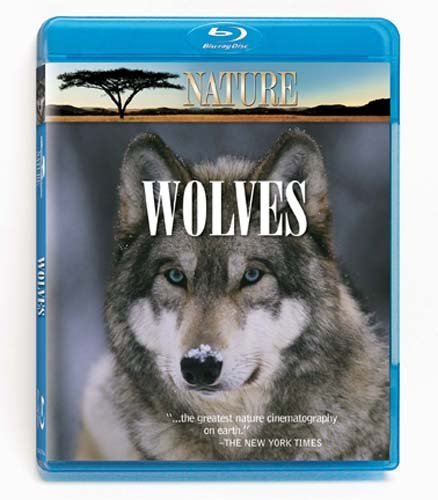One of the Rose Creek Pups in the summer of 1995 (Photo: National Park Service)Life Gives Life
Viewing and Interacting with Nature On Its Own Terms
By Christine Baleshta
It's a little after seven in the morning and 20 degrees on a day that promises to be sunny, clear and cold. The sun rises earlier each day, peaking over the hills of the Lamar Valley a little after six a.m. Winter is melting into Spring, but here, on an ice covered turnout overlooking Hellroaring Peak, winter is all around us. I kneel comfortably on a mound of snow surrounded by my companions from Yellowstone Institute and three young men sitting cross-legged behind spotting scopes wedged in spaces between the trees. They are apparently working on some unidentified study, but at this moment we all mesmerized by the same event: about two miles away, the Rose Creek Pack are lounging on the snowcovered slopes of Hellroaring Peak.
Black wolves dot the white landscape. Sometime during the night, the pack has made a kill and now they are relaxing and playing. The younger wolves play and chase each other, roughhousing in much the same way dogs play together. The kill is located on a bench above some evergreens. Some members of the pack are still eating, while others go back and forth, staying close. They all appear satisfied and relaxed.
Wolves of the Druid Peak Pack chase a group of bull elk in Yellowstone: ‘You don't question it or judge it. You must watch with an open heart and choose to learn its lessons. Those who value all species of life will accept the lesson: life gives life.’Everyone speaks in whispers. Out of the corner of my eye I watch the young men jot down notes. After years of using only binoculars, I have instantly acquired an appreciation for the spotting scope loaned to me by the Institute. Although we are so far away, I can see the shapes of the wolves and discern their features and colors. Winter is a great friend to wolf watchers, giving more visibility to this midnight colored and otherwise elusive pack. The scope provides an even greater advantage and I understand why it is the difference between "they see it and you don't."
A bull elk ventures out of the trees to the west and looks around at the scattered pack, assessing the situation. One wolf spots him and takes a few hesitant steps toward him, then breaks into a lope. At first it appears to be play. Just a wolf chasing an elk. Then another wolf joins in, and another, and another. In a matter of minutes the game of chase turns serious and it is no longer play. One wolf grabs the elk by his hind quarters while the elk continues running, falling once and getting up. In a matter of minutes there are five wolves attacking the elk from all sides and he's down. The elk half slides and is half dragged into a grove of evergreens to the west, out of view. I have witnessed my first wolf kill.
I still process that moment. The pack had just finished feasting so it is surprising that it would make another kill so soon. One would think that they would be too lazy or too stuffed to show any interest in the elk. Even coyotes are occasionally lucky enough to nibble at a wolf kill when wolves are meat drunk. But, Rosecreek is a large pack and it takes a lot of meat to keep everyone from going hungry. Wolves are opportunists and this was a big opportunity.
Druid Pack wolves trap an elk cow on a rocky ledge. Video posted at YouTube by Paul Stillmank, who writes: ‘In this second Druid Pack clip, the pack has an elk cow trapped out on a rocky ledge and they are trying to get her to run and make a mistake. She holds her ground here and ends up escaping. The footage is a little wavy because of the distance, the cold and the optics of my setup at that distance. It improves as the footage unfolds. Note that there is a sheer drop to the left of this elk, which is why she just stands there defending herself.’Watching this event is at once thrilling and disturbing. I know this is not something even a dedicated wolf watcher sees very often, but I also sympathize with the elk as much as I worry about wolves going without enough to eat. I know this is what wolves need to do to survive, but it was uncomfortable watching them in action. Surprised and annoyed at my reaction, I continue to debate myself and try not to project emotions on a situation where they have no place. When I first came to Yellowstone I realized that it is an opportunity to view and interact with nature on its terms. You don't question it or judge it. You must watch with an open heart and choose to learn its lessons. Those who value all species of life will accept the lesson: life gives life. Wolves do what they need to do in order to survive and they are good at it; otherwise, they wouldn't be here. Others who seek cruelty in predation have only to look to our own kind to find it. There are no grocery stores in the wild. There is also no waste.
The wolves have disappeared into the trees, and the cold is catching up with most of us. Perched high in a dead tree behind us, a golden eagle is being harassed by two ravens. No one thinks about how much time has passed. We watch wolves until we can no longer see them--they bed down in the trees, they walk over the hill, or darkness falls and hides them. The chance of even spotting a wolf is a roll of the dice, but patience and diligence are rewarded. We will see the Rosecreek Pack again, but now we are so cold we can barely feel our feet, so we pile into the van and head toward the comfort and warmth of Buffalo Ranch.
Christine Baleshta visited Yellowstone National Park in March of 1999. While taking a wildlife watching course from Gene Ball at the Yellowstone Association Institute, she saw a wide diversity of wildlife species exhibit their natural behavior. She currently lives in Austin, Texas. This article was originally posted at www.wolftracker.com.
***
The Druids are the most celebrated wolf pack in North America. For almost a decade, they have held the Lamar Valley in northern Yellowstone. The valley is prime winter grazing for thousands of elk and thus the most coveted wolf country in all the Park. Emmy Award-winning filmmaker Bob Landis has chronicled the adventures of the Druids since their very beginnings and in this, his third film on the wolves, the Druids find themselves in trouble for the very first time. After reaching the astonishing number of 37 members, the largest wolf-pack on record, the Druids begin to decline. Their leaders are failing with age and new packs are crossing their borders looking to claim the valley. This is the three year story of the fall and rise of the most famous wolves in America, their battles against rival wolves to hold on to their beautiful range, the dramatic twists in fortune that banish them from their valley, and the perseverance and devotion that bring them home at last. Buy the DVD. This film premiered November 2007.See the full PBS NATURE episode ‘In The Valley of the Wolves’ here
Founder/Publisher/Editor: David McGee
Contributing Editors: Billy Altman, Laura Fissinger, Christopher Hill, Derk Richardson
Logo Design: John Mendelsohn (www.johnmendelsohn.com)
Website Design: Kieran McGee (www.kieranmcgee.com)
Staff Photographers: Audrey Harrod (Louisville, KY; www.flickr.com/audreyharrod), Alicia Zappier (New York)
E-mail: thebluegrassspecial@gmail.com
Mailing Address: David McGee, 201 W. 85 St.—5B, New York, NY 10024




